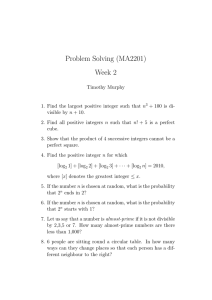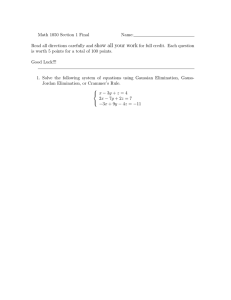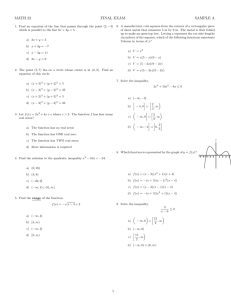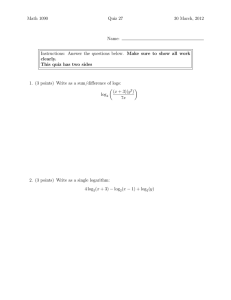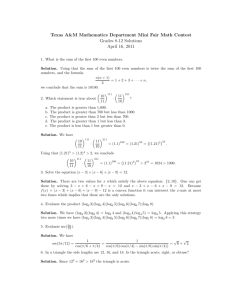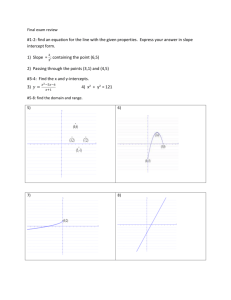2009 Leap Frog Relay Grades 9-12 Part II Solutions
advertisement
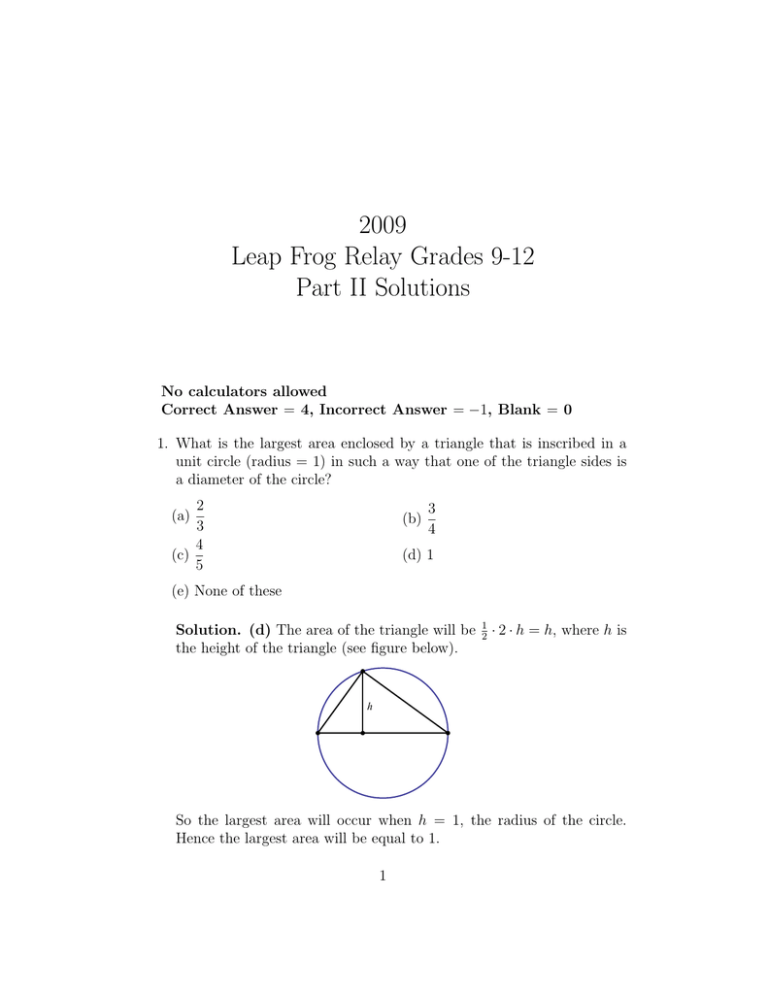
2009 Leap Frog Relay Grades 9-12 Part II Solutions No calculators allowed Correct Answer = 4, Incorrect Answer = −1, Blank = 0 1. What is the largest area enclosed by a triangle that is inscribed in a unit circle (radius = 1) in such a way that one of the triangle sides is a diameter of the circle? 2 3 4 (c) 5 (a) (b) 3 4 (d) 1 (e) None of these Solution. (d) The area of the triangle will be the height of the triangle (see figure below). 1 2 · 2 · h = h, where h is h So the largest area will occur when h = 1, the radius of the circle. Hence the largest area will be equal to 1. 1 2. Given the base-b arithmetic identity 4214b − 3141b = 1043b , the value of the base b is . (a) 8 (b) 7 (c) 6 (d) 5 (e) None of these Solution. (b) By definition, 4214b = 4b3 + 2b2 + b + 4, 3141b = 3b3 + b2 +4b+1 and 1043b = b3 +4b+3. So the identity 4214b −3141b = 1043b translates to (4b3 + 2b2 + b + 4) − (3b3 + b2 + 4b + 1) = b3 + 4b + 3. Simplifying this equality gives b2 − 7b = 0. The non-zero solution to this equation is b = 7. 3. A runner (R) and a walker (W) are positioned on diametrically opposite positions on a circular track. On the track, R is twice as fast as W. Assume they start simultaneously, move at constant velocity on the circular track, never change directions while R runs counterclockwise and W walks clockwise. How many times do R and W meet on the track in the time it takes W to go around the track two times? (a) 4 (b) 6 (c) 8 (d) 10 (e) None of these Solution. (b) Superimpose a 12-hour clock on the track. R starts at position 12 and W starts at position 6. Since R moves twice as fast as W, they meet in following positions (in order): 8, 12, 4, 8, 12, 4–which is 6 times. 4. Let T be the area of an isosceles right triangle and let C be the area of the corresponding inscribed circle to this triangle. Then, C/T = . 2 √ (4 − 2 2)π (b) 5 √ (5 − 2 2)π (d) 10 √ (a) (3 − 2 2)π √ (5 − 2 2)π (c) 8 (e) None of these Solution. (a) Since we are computing the ratio of areas, we may assume the two leg lengths of the isosceles right triangle are both equal to 1. Let r be the radius of the inscribed circle. The situation, with the indicated lengths, is pictured below. 1-r r r 1-r r 1-r r Since the hypotenuse of the right triangle is √ 2. Solving for r gives 1 r =1− √ . 2 Thus, C T = 1 2 √ 2, we must have 2 − 2r = πr2 ·1·1 !2 1 = 2 1− √ π 2 √ = (3 − 2 2)π. 5. Assume the two parabolas y = a1 x2 + b1 x + c1 , and y = a2 x2 + b2 x + c2 (with a1 6= and a2 6= 0) share the same vertex. Then, it is necessary that. . . 3 (a) a1 + b1 = a2 + b2 (b) a1 + b2 = a2 + b1 (c) a1 b2 = a2 b1 (d) a1 b1 = a2 b2 (e) None of these Solution. (c) Completing the square, we get b ax2 + bx + c = a(x2 + x) + c a !2 2 b b = a x + − 2 + c 2a 4a b = a x+ 2a !2 − b2 + c. 4a Thus, the vertex of the parabola y = ax2 + bx + c is b b2 − ,− + c . 2a 4a ! So, if y = a1 x2 + b1 x + c1 , and y = a2 x2 + b2 x + c2 share the same vertex, then − b1 b2 =− 2a1 2a2 and − b21 b2 + c1 = − 2 + c2 . 4a1 4a2 The first equality gives a1 b2 = a2 b1 , which gives a necessary condition. The other three answer choices can be eliminated using the two parabolas y = 4x2 − 8x and y = x2 − 2x − 3, which share the same vertex (1, −4). 6. Simplify the product (log2 3)(log3 4)(log4 5)(log5 6)(log6 7)(log7 8). (a) log27 33 (b) 1 (c) log2 163 (d) 4 (e) None of these 4 Solution. (e) Convert all of the logarithms to base 2 using the changeof-base formula: log2 a . logb a = log2 b Then, (log2 3)(log3 4)(log4 5) log5 6)(log6 7)(log7 8) = log2 3 · log2 4 log2 5 log2 6 log2 7 log2 8 · · · · log2 3 log2 4 log2 5 log2 6 log2 7 = log2 8 = 3, none of the answer choices provided. 7. In the picture below, the two line segments of length b are each tangent to the circle of radius a and meet in an angle θ. Then, sin θ = . b a b a Θ ab (b) √ 2 a + b2 1 (d) 2 a + b2 ab + b2 1 (c) √ 2 a + b2 (a) a2 (e) None of these Solution. (e) The segment that joins the intersection of the two tangent segments and the center of the circle bisects the angle θ. Also, the tangent is perpendicular to the radius, forming the right triangle pictured below. b a b a Θ2 a2 + b2 5 Finally, use the double angle formula for sine, θ θ cos 2 2 b a ·√ 2 = 2· √ 2 2 a +b a + b2 2ab = 2 , a + b2 none of the answer choices provided. sin θ = 2 sin 8. Upon dividing 992009 by 100, the remainder is (a) 1 (b) 99 (c) 9 (d) 19 . (e) None of these Solution. (b) Use the binomial expansion, 992009 = (100 − 1)2009 = 2009 X n=0 ! 2009 1002009−n (−1)n . n Note that every term in the sum is a multiple of 100 except the last term, which is −1. So, upon dividing by 100, the remainder will be 100 − 1 = 99. 9. If it takes x painters to paint a wall in y days (all at the same rate), how many days does it take z painters to paint the same wall? yz xy (b) 2 (a) 2 z x xz xy (c) (d) y z (e) None of these 1 Solution. (d) One painter can paint of the wall in y days. And x 1 so, one painter can paint of the wall in one day. Consequently, z xy 6 z of the wall in one day. So it would take z painters painters can paint xy xy days to paint the wall. z 10. A plane intersects a 10 × 10 × 10 cube in a regular hexagon. What is the area of the hexagon? (A regular hexagon is a six sided polygon, all of whose side lengths are equal in measure.) √ √ 3 3 2 3 2 2 (a) ft (b) ft 4 4 √ √ (c) 3 ft2 (d) 2 ft2 (e) None of these Solution. (a) In order for the intersection to be a regular hexagon, the plane must intersect six of the edges at midpoints. 1 By the Pythagorean Theorem, each side length of the hexagon is √ 2 feet. To compute the area of the hexagon, divide it into six congruent equilateral triangles. 1 h L 1 I2 7 2M 2 Again, by the Pythagorean Theorem, the altitude of this triangle is h= v u u t 1 √ 2 !2 1 − √ 2 2 !2 √ 3 = √ . 2 2 Hence, the area of the triangle is (in square feet) √ √ 1 1 3 3 . Triangle Area = · √ · √ = 2 8 2 2 2 So the hexagon area is (in square feet) √ √ 3 3 3 Hexagon Area = 6 · = . 8 4 8



